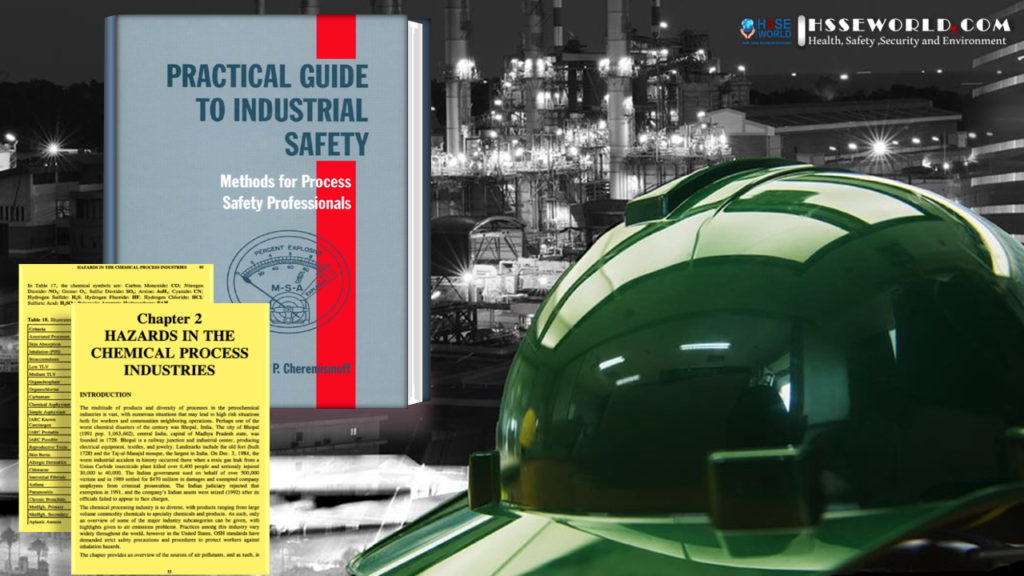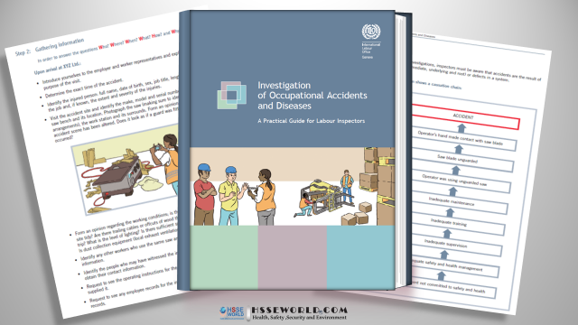The Practical Guide to Industrial Safety – Methods for Process Safety Professionals by Nicholas P. Cheremisinoff. This book has been written for process safety professionals. The intent of the volume is to provide supplemental information to assist safety specialists in managing operations in industrial settings. The subject areas covered highlight some of the more important health and safety problems involved in the chemical and allied industries. It is not intended as a handbook, and indeed many safety subjects such as hearing protection, back injuries, and stress fatigue are not covered. Instead, the book concentrates on areas of high-risk personal exposure, with emphasis on inhalation hazards and direct chemical exposure.
Industrial safety deals with the areas of safety engineering and public health that are concerned with the protection of workers’ health, through control of the work environment to reduce or eliminate hazards. Industrial accidents and unsafe working conditions can result in temporary or permanent injury, illness, or even death. They also impact reduced efficiency and loss of productivity. In the United States before 1900 the safety of workers was of little concern to employers. Only with the passage of the Workmen’s Compensation Laws and related labor statutes between 1908 and 1948 did U.S. employers start to pay attention to industrial safety; making the work environment safer was less costly than paying compensation

A new national policy was established in 1970 when for the first time all industrial workers in businesses affected by interstate commerce were covered by the Occupational Safety and Health Act. Under this act, the National Institute for Occupational Safety and Health (NIOSH) wags given responsibility for conducting research on occupational health and safety standards, and the Occupational Safety and Health Administration (OSHA) was charged with setting and enforcing appropriate standards in the industry.
The Common Industrial Fire Hazards and Prevention

Online Quiz: Top 13 Industrial Safety Objectives Questions
Various external factors, such as chemical, biological, or physical hazards, can cause work-related injury. Poor working posture or improper design of the workplace often results in muscle strains, sprains, fractures, bruises, and back pain (e.g., Repetitive Stress Injury). In recent years engineers have attempted to develop a systems approach (termed safety engineering) to industrial accident prevention. The systems approach examines all work locations to eliminate or control hazards. It also examines operating methods and practices and the training of employees and supervisors.
This first chapter serves as an introduction to the general topics and areas reviewed in various chapters.
E-Books: Industrial Hygiene Simplified(Opens in a new browser tab)
Contents
The content of the Practical Guide to Industrial Safety
- Introduction to Industrial Safety
- Environmental and Occupational Diseases
- Regulations, Laws, and Agencies
- Hazards in the Chemical Process Industries
- Introduction to International Health and Safety at Work
- Concepts of Industrial Hygiene
- Inhalation Hazards in Refineries
- Cooling Tower Operations
- Miscellaneous Air Emissions
- Handbook of Hazardous Chemical Properties
- Indoor Air Quality Management
- Personal Protective Equipment
- Foot and Hand Protection
- Eye, Face, and Head Protection
- Safety and Emergency Preparedness
- Assessing Hazards on the Job
- Safety in the Laboratory
- Safety With Machinery
- Select OSH Facts
Download the book
E-Books: Practical Guide to Industrial Safety
More Downloads
- E-Books: Healthcare Hazard Control & Safety Management
- E-Books: Safety, Health and Working Conditions Training Manual
- E-Books: Energy Efficiency in Water and Wastewater Facilities
- E-Books: Fire Service Features of Buildings and Fire Protection Systems
- E-Books: Evaluation of Fire Safety free download
- E-Books: PPE for Chemical, Biological, and Radiological Hazards free
- E-Books: Changing the Workplace Safety Culture free download
- E-Books: Site Emergency Planning Workbook
- E-Books: Load Restraint Guide
- E-Books: Essential Practices for Creating, Strengthening, and Sustaining Process Safety Culture
- E-Books: System Safety Engineering and Risk Assessment
- E-Books: Permit-Required Confined Spaces
- E-Books: Is it Safe to Enter Confined Space?
- E-Books: 5-Minute Workplace Safety Talks
- E-Books: Safety Culture and High-Risk Environments
- E-Books: Practical Guide to Industrial Safety
- E-Books: Slip, Trip, and Fall Prevention for Healthcare Workers
- E-Books: Health and Safety at Work Key Terms
- E-Books: Fundamentals of Process Safety Engineering
- E-Books: Gas Detection Hand Book
- E-Books: Occupational health and safety management systems ANSI-AIHA-z10-2012
- E-Books: Hot Work on Drums and Tanks
- E-Books: Human Fatigue Risk Management
- E-Books: Guidelines for the provision of facilities and general safety in the construction industry
- E-Books: Handbook of Training in Mine Rescue and Recovery Operations ( 2021)
- E-Books: Code of Practice for the Safe Use of Lifting Equipment – Edition 9 (Nov 2019)
- E-Books: Free Forklift Health and Safety Best Practices Guideline
- E-Books: Handbook of Hazardous Chemical Properties
- E-Books: Human Performance Improvement through Human Error Prevention
- E-Books: Principles Of Fire Risk Assessment In Buildings
- E-Books: Investigation of Occupational Accidents and Diseases
- E-Books: Radiation Protection and Safety in Industrial Radiography
- E-Books: Basic Guide to System Safety, Third Edition
- E-Books: Food Safety Management-A Practical Guide for the Food Industry
- E-Books: Safety identification: Escape and evacuation plan signs- ISO 23601
- E-Books: Safety at Work
- E-Books: The Safety-Critical Systems Handbook 4th edition
- E-Books: Fundamental principles of occupational health and safety
- E-Books: Fire Safety Risk assessment Guide – Sleeping Accommodation
- E-Books: Mental health at work series
- E-Books: Live Fire Training: Principles and Practice
- E-Books: Pre-Startup Safety Review Guide
- E-Books: Fire and Emergency Drill Manual and Building Inspection Guide
- E-Books: Health and Safety: Risk Management 5th edition
- E-Books: Fire Protection systems -Third edition 2021
- E-Books: Fire Safety Logbook templates
- E-Books: From Accidents to Zero
- E-Books: Electric Safety Practice and Standards
- Your steps to chemical safety
- E-Books: Ergonomics and Psychology Developments in Theory and Practice
- E-Books: HAZOPS Should BE fun-The Stream-Based HAZOP
- E-Books: Safety Health and Environmental Auditing
- E-Books: A Quick Guide to Health and Safety
- E-Books: Occupational Ergonomics A Practical Approach
- E-Books: Job Hazard Analysis A Guide for Voluntary Compliance and Beyond
- E-Books: Electrical Safety of Low Voltage Systems




